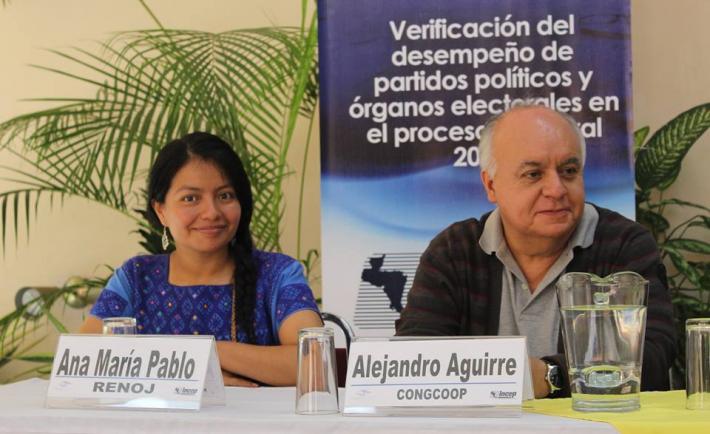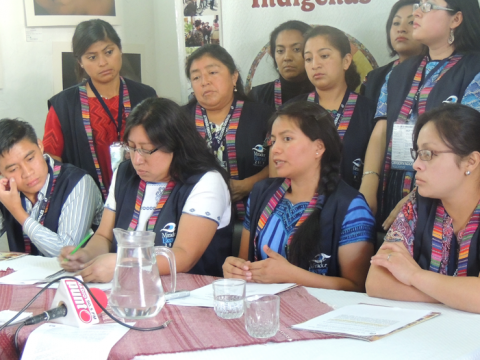
Anixh Ana María Pablo Tercero prepares to present election observation results at a press conference.
Large numbers of Guatemalan citizens are excluded from political life. Indigenous communities are among the most marginalized, as they face both institutional and cultural barriers in the country’s political system. Since the 2006 electoral reforms and during the subsequent three elections, Guatemala has seen important steps forward in terms of increased political participation; however, challenges remain in translating participation into meaningful representation.
Anixh Ana María Pablo Tercero, a Maya-Q’anjob’al woman from the Cuchumatanes mountains in northeastern Guatemala, led the electoral observation efforts conducted by the National Network of Mayan Youth (RENO’J). She worked to ensure that youth and indigenous populations could participate in the electoral process.
“I envision a society where participation translates to meaningful representation for everybody,” she said in a recent interview.
RENO’J is a national network comprised of indigenous youth organizations. In the lead up to the 2015 elections, the network worked to defend the rights of indigenous people through trainings, research and advocacy efforts. As a member of the Mirador Electoral network, RENO’J played a critical role in gathering information on discrimination and racism targeted at indigenous communities and their exclusion from politics. RENO’J also helped the other Mirador Electoral member organizations integrate indigenous issues into their observation efforts.
This was not the first time that Anixh had been involved in electoral observation. In 2003, at 19 years old, Anixh first volunteered as an election observer with the Human Rights Ombudsman in her own municipality of San Juan Ixcoy, Huehuetenango. She remained active in electoral and political processes, coordinating 2007 “quick count” activities, which serve to statistically verify the official election results, in the department of Huehuetenango. In 2011 she was involved in the observation process led by RENO’J that focused on discrimination and racism within Mirador Electoral.
“I envision a society where participation translates to meaningful representation for everybody.” - Anixh Ana María Pablo Tercero
Anixh and other observers’ commitment to participating in the elections has helped create a culture of electoral observation in Guatemala. Since Mirador Electoral began observing elections in 2003, nonpartisan citizen observers have become an integral part of the electoral process, serving as an independent check on the legitimacy of the electoral process and getting citizens more involved in their government. For RENO’J, participating in the Mirador Electoral observation created opportunities for more indigenous youth to take part in the political process.
“Mirador Electoral has played a central role in shifting the population’s view on the importance of election observation through engaging more citizens in the process and observations in more municipalities,” said Anixh. The strength of the Mirador Electoral coalition was based on its ability to bring together the diverse civil society organizations featured in this blog series to conduct a larger and more effective observation than any individual organization could do on their own.
Last year’s observation found that in 68 percent of the observed municipalities, voters were unable to participate in their first language. And while more than 40 percent of the Guatemalan population is indigenous, indigenous people comprised only 17 percent of polling station staff.
“It is a challenge to include the topic of indigenous political participation in popular discourse, but through this observation we were able to provide concrete data on discrimination and help shape public opinion,” said Anixh.
While Guatemala’s Supreme Electoral Tribunal does not measure participation rates by indigenous communities, RENO’J and the Mirador Electoral coalition observed high levels of indigenous participation. The first round elections saw record voter turnout, with approximately 70 percent of those registered to vote showing up at the polls.
However, the high levels of participation do not translate into equal representation. Just 18, or less than 12 percent, of members of congress are indigenous. Many of Guatemala’s 24 indigenous groups are not represented in congress at all.
Without significant indigenous representation, legislative initiatives that are strategic for indigenous communities have been sidelined in congress. In April 2016, reforms to the Law on Elections and Political Parties (LEPP) were approved by congress, but provisions requiring a quota for indigenous representation on political party lists did not make it into the final version of the bill despite strong support from civil society and a positive review from the Constitutional Court.
Anixh believes the future of indigenous communities hinges on changes at the national level, specifically reforms that strengthen participation and representation, as well as building capacities on the community level. “I would consider running for political office as a voice for indigenous people, but only if there are conditions for true participation,” she said.
Until then, Anixh will continue work through RENO’J and in her Maya Q’anjob’al community to strengthen the capacity of youth to lead initiatives and catalyze action within their own communities to prepare the next generation for leadership.

